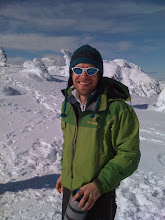 This village near Alaska's west coast was recently described to me as the lesser-known but more dramatic and urgent poster-village of climate change. The Army Corps gave it a few years before erosion and melting forced people to move, but Deborah Williams said the village could lose its water treatment plant and barge dock this summer, without which it's hard to imagine the village could function.
This village near Alaska's west coast was recently described to me as the lesser-known but more dramatic and urgent poster-village of climate change. The Army Corps gave it a few years before erosion and melting forced people to move, but Deborah Williams said the village could lose its water treatment plant and barge dock this summer, without which it's hard to imagine the village could function.It's hard for me to imagine what it's like there now. The state's community database includes this description of infrastructure.
Water is pumped from a lake into a water treatment plant, then hauled from a storage tank. In winter, melted ice is used when water in the storage tank runs dry or freezes. Households are not plumbed, and honeybuckets are used. A washeteria is available.And, just today, the NY Times' William Yardley did a moving story about the village and its changes challenges -- not just climate-related, but those surely faced by any number of Native villages here in the state.
On a recent afternoon, Ms. Tommy, 84, watched a DVD of “The Day After” while her 17-year-old granddaughter, Nicole, a high school dropout, sat across the room with Eminem’s “Encore” thumping in her headphones. Nicole mused about moving to Anchorage, although she has never been there.
Many men still travel with the seasons to hunt and fish. Some will take boats into Bristol Bay this summer to catch salmon alongside commercial fishermen from out of state. But the waterproof jacket sewn from seal gut that Stanley Tom once wore is now stuffed inside a display case at Newtok School next to other relics.
Now Mr. Tom puts on a puffy parka to walk the few hundred feet he travels to work. He checks his e-mail messages to see if there is news from the corps or from Senator Stevens while his brother, Nick, sketches out a budget proposal for a nonprofit corporation to help manage the relocation, presuming the money arrives.
Yardley also describes how there's really no public policy for village relocations yet, even though villages are moving now. It's worth reading the whole story, so click here. The pic is by Charles Mason.

No comments:
Post a Comment